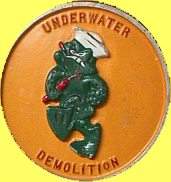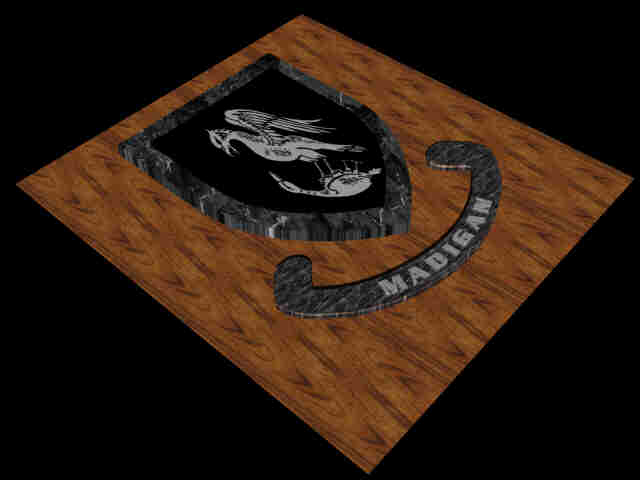The UDT -
SEAL Museum
Ft. Pierce,
FL
March 10th, 2002
As we passed
through Florida we had a chance to stop in Fort Pierce on the
Atlantic side, northeast of Lake Okeechobee. On a side street off
to one side of the town, is the only museum dedicated to a very
unique Navy unit which recently has come into popularity. The plaque on the outside of the museum read
"In memory of our fallen comrades who have sacrificed their
lives in the service of their country while serving in the United
States Navy with Naval combat demolition units, scouts, raiders,
underwater demolition teams and the Sea Air and Land Teams. After
a short introduction at the front door, we entered the museum and
began learning about "Amphibious warfare". Amphibious
warfare is the use of water to gain a land objective. The U.S.
Navy has accomplished such operations since the beginnings of our
nation. During the 18th and 19th centuries, the Navy drew its
amphibious forces from ship's companies of sailors and Marines
and landed units on foreign soil to protect U.S. interests. When
necessary, the Army would participate by providing more
substantial units, such as during the Civil War and the
Spanish-American War. During conflicts of the time, U.S. forces
relied
passed
through Florida we had a chance to stop in Fort Pierce on the
Atlantic side, northeast of Lake Okeechobee. On a side street off
to one side of the town, is the only museum dedicated to a very
unique Navy unit which recently has come into popularity. The plaque on the outside of the museum read
"In memory of our fallen comrades who have sacrificed their
lives in the service of their country while serving in the United
States Navy with Naval combat demolition units, scouts, raiders,
underwater demolition teams and the Sea Air and Land Teams. After
a short introduction at the front door, we entered the museum and
began learning about "Amphibious warfare". Amphibious
warfare is the use of water to gain a land objective. The U.S.
Navy has accomplished such operations since the beginnings of our
nation. During the 18th and 19th centuries, the Navy drew its
amphibious forces from ship's companies of sailors and Marines
and landed units on foreign soil to protect U.S. interests. When
necessary, the Army would participate by providing more
substantial units, such as during the Civil War and the
Spanish-American War. During conflicts of the time, U.S. forces
relied  on established ports for major landings. Minor
raids could utilize boats and craft of the Navy ships. As our
nation has grown, the Navy with the other armed forces, has
developed plans and technology to land anywhere and meet
strategic and tactical goals for National interest. The strategy
for fighting a world war actually can be traced back to the
1920s. U.S. forces fought "war games" to practice
tactics as well as to develop ideas and technology for defending
strategic interest and defeating the enemy. The Japanese attack
on Pearl Harbor launched the U.S. into a new role as a world
power. To defeat the Axis powers, Japan, Germany and Italy, the
U.S. expanded its armed forces dramatically. By 1945 it had 11.7
million men and women in uniform. Before the U.S. could carry the
on established ports for major landings. Minor
raids could utilize boats and craft of the Navy ships. As our
nation has grown, the Navy with the other armed forces, has
developed plans and technology to land anywhere and meet
strategic and tactical goals for National interest. The strategy
for fighting a world war actually can be traced back to the
1920s. U.S. forces fought "war games" to practice
tactics as well as to develop ideas and technology for defending
strategic interest and defeating the enemy. The Japanese attack
on Pearl Harbor launched the U.S. into a new role as a world
power. To defeat the Axis powers, Japan, Germany and Italy, the
U.S. expanded its armed forces dramatically. By 1945 it had 11.7
million men and women in uniform. Before the U.S. could carry the war to the
enemy, it has to train men. Before and after Pearl Harbor, the
U.S. Navy opened schools, training bases and laboratories.
Planners realized that amphibious warfare would be necessary in
both the European and Pacific theaters. American commanders
planning for the war in Europe mapped out a series of strategic
moves to carry the war to victory. In August 1942, realizing the
need for detailed beach information, Adm. H. K. Hewitt, commander
of U.S. Atlantic amphibious forces, ordered Lt. Lloyd Peddcord,
U.S. Army, to establish the Joint Amphibious Scout and Raider
School at the Naval Amphibious Training Base in Little Creek Va.
The whole operation started off with one officer and five men.
The first equipment was nothing more then swimming trunks and a
knife, and a slate that could be written on underwater. Later on,
fins and face masks became standard. By 1943, the Naval Combat
Demolition Units, forerunner of the UDT and SEAL teams were
established. Although a small number of NCDU men were involved in
operations in Sicily and the Pacific, the primary focus of these
six or 7 man units was the invasion of Normandy. Throughout the
training, close team concept designed to develop outstanding
esprit de corps was emphasized. These principles are as true to
the training today as it was in the beginning. Reconnaissance
war to the
enemy, it has to train men. Before and after Pearl Harbor, the
U.S. Navy opened schools, training bases and laboratories.
Planners realized that amphibious warfare would be necessary in
both the European and Pacific theaters. American commanders
planning for the war in Europe mapped out a series of strategic
moves to carry the war to victory. In August 1942, realizing the
need for detailed beach information, Adm. H. K. Hewitt, commander
of U.S. Atlantic amphibious forces, ordered Lt. Lloyd Peddcord,
U.S. Army, to establish the Joint Amphibious Scout and Raider
School at the Naval Amphibious Training Base in Little Creek Va.
The whole operation started off with one officer and five men.
The first equipment was nothing more then swimming trunks and a
knife, and a slate that could be written on underwater. Later on,
fins and face masks became standard. By 1943, the Naval Combat
Demolition Units, forerunner of the UDT and SEAL teams were
established. Although a small number of NCDU men were involved in
operations in Sicily and the Pacific, the primary focus of these
six or 7 man units was the invasion of Normandy. Throughout the
training, close team concept designed to develop outstanding
esprit de corps was emphasized. These principles are as true to
the training today as it was in the beginning. Reconnaissance  and obstacle
clearance became an important first step in any landing, to
choose the best areas for invading an enemy coast and minimizing
losses to our own forces. Commanders recognized the need for
small "special" units to hit the beach ahead of an
assault force. The men would be chosen from a variety of fleet
specialties to lead landing operations. The Navy established an
amphibious training base at Fort Pierce, Florida, to enable
sailors to practice and hone their skills year-round. Capt. C.
Gulbranson, USN, commissioned the base on January 26, 1943. His
headquarters were in the Burston Building downtown Fort Pierce.
The base quickly became a center of activity for many different
phases of amphibious warfare. Sailors were trained in gunnery,
boat and amphibious vehicle landings; beach supervision and
salvage, reconnaissance and demolition. The base had a dramatic
impact on this part of the eastern Florida coast. The previously
uninhabited north and south barrier islands became housing and
training areas for thousands of troops passing through its
schools. Day and night, the sights and sounds of ships and boats
became commonplace. Explosions from Naval Combat Demolition Units
and Scout and Raider
and obstacle
clearance became an important first step in any landing, to
choose the best areas for invading an enemy coast and minimizing
losses to our own forces. Commanders recognized the need for
small "special" units to hit the beach ahead of an
assault force. The men would be chosen from a variety of fleet
specialties to lead landing operations. The Navy established an
amphibious training base at Fort Pierce, Florida, to enable
sailors to practice and hone their skills year-round. Capt. C.
Gulbranson, USN, commissioned the base on January 26, 1943. His
headquarters were in the Burston Building downtown Fort Pierce.
The base quickly became a center of activity for many different
phases of amphibious warfare. Sailors were trained in gunnery,
boat and amphibious vehicle landings; beach supervision and
salvage, reconnaissance and demolition. The base had a dramatic
impact on this part of the eastern Florida coast. The previously
uninhabited north and south barrier islands became housing and
training areas for thousands of troops passing through its
schools. Day and night, the sights and sounds of ships and boats
became commonplace. Explosions from Naval Combat Demolition Units
and Scout and Raider  exercises could be heard and seen. While ships
lay off the coast, landing craft and rubber boats laden with men
approached enemy shores to gather information, blow up obstacles
and report to "invasion commanders" the result of their
work. Combat reconnaissance and demolition took only volunteers
who had to meet tough physical standards and complete a rigorous
training program. Most of the protection for these men came from
the sea. They learned to use camouflage and concealment to hide
their approach. The sailors at Fort Pierce learned many different
techniques, including the use of clothing, underwater breathing
apparatus and small boat tactics.
exercises could be heard and seen. While ships
lay off the coast, landing craft and rubber boats laden with men
approached enemy shores to gather information, blow up obstacles
and report to "invasion commanders" the result of their
work. Combat reconnaissance and demolition took only volunteers
who had to meet tough physical standards and complete a rigorous
training program. Most of the protection for these men came from
the sea. They learned to use camouflage and concealment to hide
their approach. The sailors at Fort Pierce learned many different
techniques, including the use of clothing, underwater breathing
apparatus and small boat tactics.
